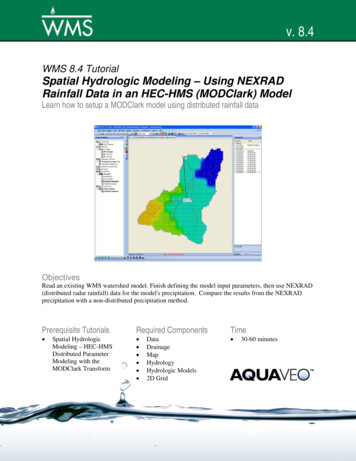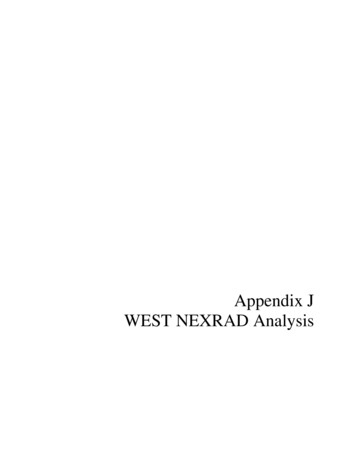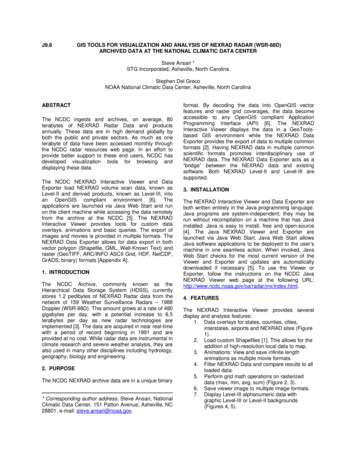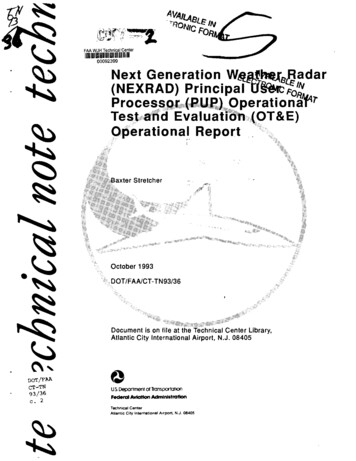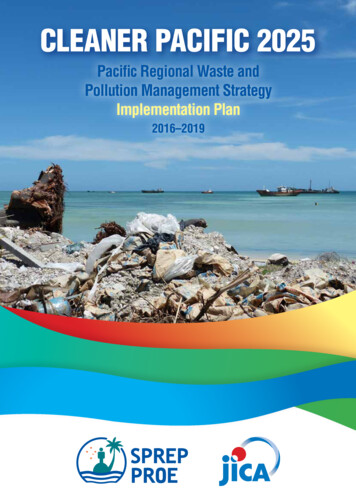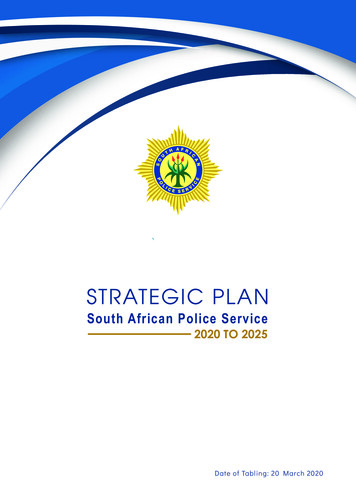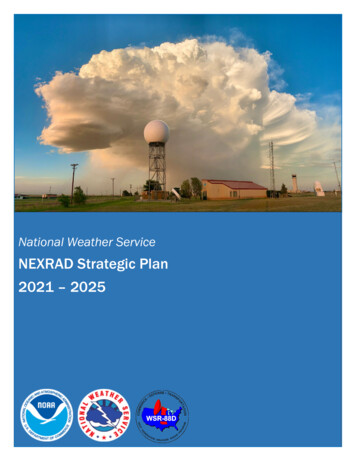
Transcription
National Weather ServiceNEXRAD Strategic Plan2021 – 20251
NEXRAD is the Premier System for Hazardous Weather DetectionNEXRAD is a tri-agency system instrumental in assisting the National Weather Service (NWS), Departmentof Defense (DoD), and Federal Aviation Administration (FAA) in meeting mission objectives. The system’sperformance meets or exceeds the 96% operational availability requirement to reliably observe and detecthazardous weather; support forecast/warning programs; protect lives, property, and military assets; promote asafe and efficient National Airspace System, and enhance the nation’s economy. Since deployment began in1992, the NEXRAD program has executed a continuous program of modifications, retrofits, technologyrefreshments, and pre-planned product improvement upgrades. The goal of this effort has been to extendsystem life, upgrade functionality and capabilities, improve data quality, meet new mission requirements,improve system maintainability and reliability, and control NEXRAD operations and maintenance (O&M)costs. The Service Life Extension Program (SLEP) began in 2015 and will continue into 2024. SLEP consistsof five projects to replace and refurbish major components of the radar: signal processor, transmitter,equipment shelters, pedestal, and backup generator. As a result of these sustaining engineering, hardware, andtechnology refresh investments, NEXRAD continues to be upgradable, reliable, and maintainable beyond 2035or until a suitable replacement for the WSR-88D is deployed.In the NEXRAD network, there are 12 FAA, 25 DoD, and 122 NWS operational radars. The NWS alsooperates 10 support systems for training, parts refurbishment, and testing of hardware and softwaremodifications. The Radar Operations Center (ROC) budget supports daily ROC operations, depot-level radarmaintenance, and system modification costs that are equitably shared in accordance with the tri-agency signedCost Share Allocation Memorandum of Agreement (MOA).By tri-agency agreement, the NWS Office of Observations (OBS) is responsible for overall NEXRAD programmanagement, the ROC in Norman, Oklahoma, is responsible for support management, and both perform thesefunctions under the authority of the tri-agency NEXRAD Program Management Committee (NPMC). TheNPMC oversees the NEXRAD program budget, policy, and resource commitment, and provides managementguidance throughout the life cycle of the NEXRAD program to ensure that both common and unique agencyrequirements are addressed and resolved. The day-to-day operations and management of the NEXRADProgram are directed from the tri-agency ROC with the ROC Director serving the NPMC as the IntegrationProgram Manager while organizationally reporting to the OBS Director. The OBS Director serves as the DOCrepresentative for the NPMC.2
Table of ContentsMission, Stakeholders & Priorities4Strategic Alignment5NEXRAD Strategy: Current State7NEXRAD Strategy: Future State8Program Gap Analysis9References9NEXRAD Coverage103
Mission, Stakeholders & PrioritiesThe mission of the program is to sustain the capability of the tri-agency NEXRAD network to reliably observeand detect hazardous weather in support of forecast and warning programs, protection of military assets, theNational Airspace System, and the national economy through timely infusion of technology transition and newcapabilities.The NEXRAD Program is a tri-agency strategic partnership that oversees the program management of theoperational radar network. The groups and organizations affected by program decisions, activities, or outcomesinclude:1.2.3.4.5.6.Regional offices of the NWS, Air Force, and FAAField offices of the NWS, Air Force, and FAALine offices of the tri-agency partnersWeather, Water, and Climate EnterpriseMediaGeneral publicPriorities for the NEXRAD Program:1.2.3.4.5.Keep operational radar systems runningSustain baseline operational radar system capabilitiesImprove radar system reliabilityIntegrate new capabilities into the radar systemSupport product improvement programsRadar Operations Center sustains life-cycle operations for all WSR-88D systems in the areas of:1.2.3.4.5.6.7.Centralized software/algorithm development, testing, and maintenanceField supportEngineering managementConfiguration managementModification development and deploymentTechnical documentationOn-site depot maintenanceSupply support management and centralized depot parts repair are the responsibility of the NWSLogistics Management Branch. The NWS Office of the Chief Learning Officer provides NEXRADoperator and maintenance training via the Warning Decision Training Division (WDTD) and NWSTraining Center (NWSTC), respectively.4
Strategic AlignmentNEXRAD provides essential data needed to achieve DOC/NOAA/NWS strategic objectives and goals. Noother observation system is capable of providing these unique remote sensing data.Department of Commerce (DOC):Strategic Goal – Strengthen U.S. Economic and National SecurityStrategic Objective – Reduce Extreme Weather ImpactsKey strategies include:1. Evolve the National Weather Service to deliver better forecasts, earlier warnings, and clearercommunication of high-impact weather and water events.2. Strengthen partnerships with America’s weather industry and other members of the weather, water, andclimate enterprise.3. Deploy the next generation of satellites, aircraft, ocean-going ships, and observation and data gatheringsystems.4. Develop and deploy next-generation environmental observation and modeling systems to makeinformed planning, resources management, and investment decisions.National Oceanic and Atmospheric Administration (NOAA):Future Vision – Healthy ecosystems, communities, and economies that are resilient in the face of changeLong-term Goal – Weather-Ready NationObjectives to achieve this goal include:1.2.3.4.5.Reduced loss of life, property, and disruption from high-impact eventsImproved freshwater resource managementImproved transportation efficiency and safetyHealthy people and communities due to improved air and water quality servicesA more productive and efficient economy through environmental information relevant to key sectors ofthe U.S. economy5
Strategic AlignmentNational Weather Service (NWS):Strategic Plan – A Weather-Ready Nation: Society is prepared for and responds to weather, water, andclimate-dependent events.Strategic Plan Goals include:1. Reduce the impacts of weather, water, and climate events by transforming the way people receive,understand, and act on information.2. Harness cutting-edge science, technology, and engineering to provide the best observations, forecasts,and warnings.3. Evolve the NWS to excel in the face of change through investment in our people, partnerships, andorganizational performance.A core foundation of the NWS infrastructure is its observational systems. NWS relies on an integrated suiteof observations and nationwide observational systems, including NEXRAD, to accurately detect, analyze, andforecast weather events. Data from these observational systems are used 24/7 in support of NWS’ coreweather, water, and climate mission.DOC Strategic Plan: 8/us department of commerce 2018-2022 strategic plan.pdfNOAA Strategic Plan: https://www.performance.noaa.gov/ngsp/NWS Strategic Plan: https://www.weather.gov/media/wrn/NWS Weather-ReadyNation Strategic Plan 2019-2022.pdf6
NEXRAD Strategy: Current StateThe NEXRAD program will continue to be well served by the following high-level strategy that has sustainedthe network’s operational availability at or above 96%:1. Maintain the strategic alliance with tri-agency partners to control NEXRAD costs, as codified inMOAs and the Integrated Logistics Support Plan (ILSP) (see References).a.Use a cost-effective model for supporting operations and maintenance through use ofcommon operator and maintenance manuals, shared spares stock, and shared supportinfrastructure, including the ROC.b.Use a robust program support infrastructure at the ROC to provide depot-levelmaintenance and on-going sustaining engineering, operator and maintainer training, andcommon management of logistics, facilities, spectrum, safety, and IT security.2. Continuously improve the NEXRAD system by infusing new and improved radar science andcommunications/computer technology to address evolving operational requirements bymaintaining synergy with key partners.a.Collaborate with source scientists at the National Severe Storms Laboratory (NSSL),National Center for Atmospheric Research (NCAR), and MIT Lincoln Laboratory to improvedual polarization data quality through algorithm tuning and calibration enhancements.b.Implement signal processing advancements in the WSR-88D by leveraging NSSL’sPhased Array Radar (PAR) risk reduction research.3. Maintain NEXRAD reliability, availability (96%), and maintainability through a continuousprogram of technology refresh modification (hardware and software), and a robust depot-levelmaintenance capability.a.Continue to use the NEXRAD 8-Year Modification Plan, updated annually incoordination with tri-agency stakeholders, to plan and budget for ongoing hardwaretechnology refresh modifications needed to sustain reliable operations.b.Continue to use the tri-agency NEXRAD governance process to define software releasecontents and schedules, and prioritize technical needs and evaluate the science of R&Dproposals.c.Operate a 24/7 NEXRAD Hotline assisting radar sites with technical support.d.Maintain a cadre of specially trained radar technicians providing on-site depot-levelmaintenance.e.Maintain active task order contracts for on-site depot-level maintenance of radar towersand radomes for continuous preventative and restorative maintenance.f.Maintain a NEXRAD Reconstitution Plan, along with strategic spares stock of long-leadtime components, for restoring radar operations lost to natural events such as hurricanes,floods, wildfires, or severe storms.7
NEXRAD Strategy: Future State Extend the useful life of the NEXRAD fleet beyond 2035 through completion of the Service LifeExtension Program (SLEP) and sustaining engineering. Work with government partners to leverage supplemental radar data, where applicable, and ingest thosedata into NOAA’s Multi-Radar Multi-Sensor (MRMS) System. Support the tri-agencies in determining a practical and feasible solution for weather radar coverage from2035 and beyond, exploring all options including phased array technology, a new rotating dish radarsystem, and the continuation of NEXRAD. Continue efforts to address interference and beam blockage. This includes interference from crowding ofthe frequency spectrum and wind turbines, as well as natural and man-made blockages from trees andstructures.8
Program Gap AnalysisThese issues can result in deviations from planned NEXRAD program activities with little to no advancednotice:Technology Refresh:Costs vary from year to year depending on component obsolescence and sustaining engineering analyses,resulting in variances to the estimates contained within the 8-Year Modification Plan.Radar Asset Recovery and/or Relocations:Costs incurred to relocate a NEXRAD system to meet new coverage requirements, address coverage factorssuch as blockages, or recover and restore a system which has sustained significant damage. Partner agencyrequirements may also change, resulting in the excessing of valuable NEXRAD components.Interference and Blockages:Costs incurred while addressing issues associated with packing of the frequency spectrum, interference(e.g. wind farms, wireless emitters, other radars), and blockages from natural and man-made structures (e.g.trees, buildings, water towers).Unfunded Mandates:Downward directed policy decisions that result in unplanned capital expenditures for items such as IT security,IT system monitoring, etc.References Memorandum of Agreement (MOA) among the Department of Commerce (DOC), Department ofTransportation (DOT), and Department of Defense (DoD) for Allocation of Program Costs of the NextGeneration Weather Radar (NEXRAD) Program, October 2019. Memorandum of Agreement (MOA) among the Department of Commerce (DOC), Department ofTransportation (DOT), and Department of Defense (DoD) for Interagency Operation of the WeatherSurveillance Radar-1998 Doppler (WSR-88D), March 2021. NEXRAD Integrated Logistics Support Plan (ILSP), May 2020.9
NEXRAD Coverage10
maintenance. e. Maintain active task order contracts for on-site depot-level maintenance of radar towers and radomes for continuous preventative and restorative maintenance. f. Maintain a NEXRAD Reconstitution Plan, along with strategic spares stock of long-lead time components, for restoring radar operations lost to natural events such as .
